IT___
Il mio primo esperimento multimediale-interattivo è avvenuto in occasione della rappresentazione del racconto noir “Pickman’s Model” di H.P. Lovecraft.
Un televisore posto alle spalle dell’attore in scena proietta le immagini di un video girato in piano sequenza nel sottopasso di Porta Nuova, in cui il protagonista del racconto recita, in costume d’epoca vittoriana, il racconto di Lovecraft.
Protagonista l’attore Gabriele Calindri.
Il contrasto tra l’ambiente contemporaneo, con le pareti segnate dai graffiti e dalle vetrine del sottopasso ferroviario e la scelta filologica del costume indossato dall’interprete, ha determinato una dissonanza temporale che è poi ribaltata in scena nel doppio ruolo di attore e doppiatore in abiti moderni durante la performance teatrale.
Il doppiaggio è stato agevolato dall’utilizzo di uno specchietto retrovisore, posto sul leggio, che ha permesso all’attore/doppiatore di poter vedere la propria immagine in movimento alle sue spalle e di doppiare il labiale in sincrono come in una sala di doppiaggio.
Lo straniamento luogo-temporale diventa realtà aumentata con l’ausilio delle luci monocromatiche che, sfruttando la teoria della psicologia del colore, ha coinvolto a livello emozionale il pubblico dell’inusuale rappresentazione del testo di Lovecraft.
A completare la performance, le musiche live di Giorgio Li Calzi.
L’audio della rappresentazione è diffusa da un impianto dolby surrond, usato per la separazione dei canali, per l’ascolto selettivo di musica e parole.
Le sale della Fondazione per la Fotografia di Torino si sono trasformati per l’occasione in un luogo performativo tra teatro dell’ascolto e linguaggio multimediale di interazione.
Per raccontare il dietro le quinte dell’allestimento, è stato montato, sul brano musicale “Angel” dei Massive Attack, il video in forma di collage “The Pickman Show”, contenente alcune scene tagliate del video “The Pickman’s Model” e alcuni brani tratti dal videoclip musicale “Karma Police” dei Radiohead.
Un televisore posto alle spalle dell’attore in scena proietta le immagini di un video girato in piano sequenza nel sottopasso di Porta Nuova, in cui il protagonista del racconto recita, in costume d’epoca vittoriana, il racconto di Lovecraft.
Protagonista l’attore Gabriele Calindri.
Il contrasto tra l’ambiente contemporaneo, con le pareti segnate dai graffiti e dalle vetrine del sottopasso ferroviario e la scelta filologica del costume indossato dall’interprete, ha determinato una dissonanza temporale che è poi ribaltata in scena nel doppio ruolo di attore e doppiatore in abiti moderni durante la performance teatrale.
Il doppiaggio è stato agevolato dall’utilizzo di uno specchietto retrovisore, posto sul leggio, che ha permesso all’attore/doppiatore di poter vedere la propria immagine in movimento alle sue spalle e di doppiare il labiale in sincrono come in una sala di doppiaggio.
Lo straniamento luogo-temporale diventa realtà aumentata con l’ausilio delle luci monocromatiche che, sfruttando la teoria della psicologia del colore, ha coinvolto a livello emozionale il pubblico dell’inusuale rappresentazione del testo di Lovecraft.
A completare la performance, le musiche live di Giorgio Li Calzi.
L’audio della rappresentazione è diffusa da un impianto dolby surrond, usato per la separazione dei canali, per l’ascolto selettivo di musica e parole.
Le sale della Fondazione per la Fotografia di Torino si sono trasformati per l’occasione in un luogo performativo tra teatro dell’ascolto e linguaggio multimediale di interazione.
Per raccontare il dietro le quinte dell’allestimento, è stato montato, sul brano musicale “Angel” dei Massive Attack, il video in forma di collage “The Pickman Show”, contenente alcune scene tagliate del video “The Pickman’s Model” e alcuni brani tratti dal videoclip musicale “Karma Police” dei Radiohead.
EN___
My first multimedia-interactive experiment took place on the occasion of the representation of the noir story "Pickman's Model" by H.P. Lovecraft.
A television set behind the actor on stage projected the images of a long take video shot in the Porta Nuova Station underpass, in which the protagonist of the story recited Lovecraft's story in a Victorian period costume. The protagonist was the actor Gabriele Calindri.
The contrast between the contemporary environment, with the walls marked by graffiti and the windows of the railway underpass, and the philological choice of the interpreter’s costume determined a temporal dissonance which was then overturned on stage in the double role of actor and voice actor in modern clothes during the theatrical performance.
The dubbing was facilitated by the use of a rear-view mirror, placed on the lectern, which allowed the actor/voice actor to be able to see his own image in motion behind him and to dub his lip in sync as in a dubbing room.
The place-time estrangement became virtual reality with the help of monochromatic lights. The use of the psychology of color got the audience emotionally involved in the unusual representation of Lovecraft's text. To complete the performance, live music of Giorgio Li Calzi was played.
The audio of the performance was broadcasted by means of a dolby surround system for the selective listening of music and words.
For this occasion the rooms of the Turin Photography Foundation had been transformed into a performative set between listening theater and multimedia language of interaction.
To share the behind the scenes details of the performance and installation, video editing on track music "Angel" by Massive Attack, was used in the form of a collage called “The Pickman Show”.
The video contained some deleted scenes from the video "The Pickman's Model" and some excerpts from Radiohead's "Karma Police" music video.
A television set behind the actor on stage projected the images of a long take video shot in the Porta Nuova Station underpass, in which the protagonist of the story recited Lovecraft's story in a Victorian period costume. The protagonist was the actor Gabriele Calindri.
The contrast between the contemporary environment, with the walls marked by graffiti and the windows of the railway underpass, and the philological choice of the interpreter’s costume determined a temporal dissonance which was then overturned on stage in the double role of actor and voice actor in modern clothes during the theatrical performance.
The dubbing was facilitated by the use of a rear-view mirror, placed on the lectern, which allowed the actor/voice actor to be able to see his own image in motion behind him and to dub his lip in sync as in a dubbing room.
The place-time estrangement became virtual reality with the help of monochromatic lights. The use of the psychology of color got the audience emotionally involved in the unusual representation of Lovecraft's text. To complete the performance, live music of Giorgio Li Calzi was played.
The audio of the performance was broadcasted by means of a dolby surround system for the selective listening of music and words.
For this occasion the rooms of the Turin Photography Foundation had been transformed into a performative set between listening theater and multimedia language of interaction.
To share the behind the scenes details of the performance and installation, video editing on track music "Angel" by Massive Attack, was used in the form of a collage called “The Pickman Show”.
The video contained some deleted scenes from the video "The Pickman's Model" and some excerpts from Radiohead's "Karma Police" music video.
PICKMAN'S NOVEL by H.P. Lovecraft
directed by Oliviero Corbetta
Actor: Gabriele Calindri
Video shot underpass Porta Nuova: Michele Di Mauro
Live music: Giorgio LiCalzi
Set design, Costume design, Video behind the scenes: Monica Chiappara
Light design, Editing Video: Davide Leone
Production: F.I.F. - 1998 -1999 (Fondazione Italiana per la Fotografia di Torino)
TECHNICAL DATA:
1TELEVISION
1 LECTERN
1 REAR MIRROR
CHANGE COLOR LIGHT
1 AUDIO MIXER - DIMMER LIGHTS - LOUDSPEAKERS
L'ANITRA SELVATICA (THE WILD DUCK) by Henrik Ibsen
directed by Oliviero Corbetta
Actors: Enrico Bertorelli, Marco Morellini, Adolfo Fenoglio, Gabriele Calindri, Luisa Ziliotto, Lorenza Ferro, Francesca Vettori, Enrico
Maggi, Alberto Hoiss, Andrea Fazzari, Oliviero Corbetta
SET DESIGN - COSTUME DESIGN - ART DIRECTION - VIDEO INSTALLATION - VIDEO INTRO
Artistic supervisor: Monica Chiappara
Light design - Video editing: Davide Leone
Live music: Giorgio Li Calzi
Photo: Roberto Goffi
Production: F.I.F. - 2001 (Fondazione Italiana per la Fotografia di Torino)
Teatro Agnelli, Torino
TECHNICAL DATA:
2 PROJECTOR - FRONT/REAR
1 REAR PROJECTION SCREEN
1 COMPUTER PC
1 AUDIO MIXER - 1 DMX LIGHT MIXER
MICROPHONES - LOUDSPEAKERS
11 LECTERNS
TULLE CINECITTA' WHITE
ALLUMINIUM TUBE
IT___
La multimedialità in teatro: “Oceano” non è una password. Venezia, 1995.
E’ l’eco di un ricordo, è il riverbero di immagini sfocate come le figure “sospese” e “in cammino” di Bill Viola nella sua opera “The Veiling”.
E’ l’eco di un ricordo, è il riverbero di immagini sfocate come le figure “sospese” e “in cammino” di Bill Viola nella sua opera “The Veiling”.
La video arte della seconda metà degli anni novanta, le opere visive di Bill Viola, i disegni in stop motion di William Kentridge, le immagini elettroniche e i televisori a tubo catodico di Nam June Paik, hanno influenzato la messa in opera delle scenografie realizzate per gli spettacoli prodotti dalla Fondazione Italiana per la Fotografia di Torino la cui regia è stata affidata a Oliviero Corbetta del Gruppo della Rocca.
La progettazione e l’allestimento degli spettacoli teatrali, implicano più aspetti di ricerca, tecnica e artistica.
La progettazione e l’allestimento degli spettacoli teatrali, implicano più aspetti di ricerca, tecnica e artistica.
Il prezioso e complesso lavoro svolto in collaborazione con il regista sonda i vari aspetti della drammaturgia scenica e trasforma la parola scritta e la descrizione degli ambienti della rappresentazione in un luogo tangibile che può essere naturalistico oppure diventare parte della drammaturgia come spazio utopico o metaforico.
Per "L'Anitra Selvatica" di Henrik Ibsen il regista Oliviero Corbetta propose un racconto fotografico in forma di fotoromanzo, riproposto come proiezione in teatro e recitato dagli stessi attori del fotoromanzo nella forma di lettura scenica accompagnata da musiche dal vivo nella rappresentazione teatrale. La location principale per gli scatti fotografici fu una villa di campagna borghese di epoca ottocentesca. Nella villa c'erano a disposizione l'arredamento e gli oggetti di scena necessari per realizzare gli scatti fotografici. Per i personaggi proposi al regista un trattamento dei costumi di scena non filologici al testo ma che fossero un'allegoria del paesaggio nordico e riassumesse la ripetibilità dei caratteri ibseniani.
I personaggi de "L'Anitra Selvatica" sono gli stessi che abitano "Casa di bambola" e "Spettri". I costumi indossati dagli attori sarebbero stati bianchi, degli schermi su cui proiettare immagini allegoriche ed evocative.
Per realizzare i costumi scelsi un prodotto altamente tecnico a base d'acqua da spatolare su cappotti e giacche militari, gonne, pantaloni, gilet, scarpe; un prodotto leggermente gommoso, che avrebbe impedito l'irrigidimento degli indumenti, per permettere agli attori movimenti naturali e che non sporcassero gli arredi con cui sarebbero venuti a contatto. La realizzazione dei costumi fu impegnativo e occorsero molte ore di lavoro anche per permettere la completa asciugatura del materiale gommoso applicato sugli abiti.
Per realizzare i costumi scelsi un prodotto altamente tecnico a base d'acqua da spatolare su cappotti e giacche militari, gonne, pantaloni, gilet, scarpe; un prodotto leggermente gommoso, che avrebbe impedito l'irrigidimento degli indumenti, per permettere agli attori movimenti naturali e che non sporcassero gli arredi con cui sarebbero venuti a contatto. La realizzazione dei costumi fu impegnativo e occorsero molte ore di lavoro anche per permettere la completa asciugatura del materiale gommoso applicato sugli abiti.
I personaggi sono stati ritratti dal fotografo Roberto Goffi coadiuvato dalle luci di Davide Leone e dalla regia di Oliviero Corbetta.
Nel video, ad inizio spettacolo, la telecamera viaggia negli ambienti a scoprire i luoghi della villa in cui è ambientata la vicenda narrata da Ibsen. Gli arredi coperti da lenzuola, come nella case disabitate, sono la suggestione che anticipa il doppio gioco dei personaggi raccontati come fantasmi nella messa in scena fotografica e incastrati in uno spazio atemporale.
La scenografia teatrale era molto semplice come impianto; uno schermo in tulle cinecittà bianco era disposto sul palco per la proiezione frontale, due piccole "vele" laterali simmetriche, sempre in tulle cinecittà, fungevano da quinte a precedere lo schermo principale. L'effetto era particolarmente evanescente e ispirato alle opere visive fluttuanti di Bill Viola. La disposizione registica in scena degli attori illuminati a leggio e della musica dal vivo non mi permise di aumentare gli schermi di tulle disposti in prospettiva per suggerire l'eco visivo delle immagini, aumentarne la forza evocativa e la lettura visiva. Un ulteriore schermo da retroproiezione venne quindi posto in scena per rafforzare la presenza delle immagini, questa aggiunta annullò purtroppo in parte l'effetto schermo velo del tulle.
In proscenio, davanti alla scena per tutta la durata dello spettacolo, Hedvig la protagonista adolescente del dramma Ibseniano, interpretata dalla giovanissima Lorenza Ferro.
EN___
Multimedia in the theatre: "Ocean” is a password. 1995, Venice. It's the echo of a memory: it's the reverberation of blurred images such as the "suspended" and "walking" figures of Bill Viola in his work "The Veiling".
The video art of the second half of the nineties, the visual works of Bill Viola, the stop motion drawings of William Kentridge, the electronic images and cathode ray tube televisions of Nam June Paik, have influenced the implementation of the sets created for the shows produced by the Italian Foundation for Photography of Turin directed by Oliviero Corbetta of the Gruppo della Rocca. The design and staging of theatrical performances involve several aspects of research, technique and art.
The precious and complex work carried out in collaboration with the director probes the various aspects of the scenic dramaturgy and transforms the written word and the description of the environments of the representation into a tangible place that can be naturalistic or become part of the dramaturgy as a utopian or metaphorical space.
For Henrik Ibsen's "The Wild Duck" the director Oliviero Corbetta proposed photographic storytelling in the form of a photo novel, as a projection in the theater and performed by the same actors of the photo novel in the form of scenic reading accompanied by live music in the theatrical representation. The main location for the photographs was a nineteenth-century bourgeois country villa. The furniture and props needed to create the photographic shots were available in the villa. Regarding the characters my proposal to the director was a treatment of stage costumes that were not philological to the text but which were an allegory of the Nordic landscape and summed up the repeatability of the Ibsenian characters.
The characters of "The Wild Duck" are the same ones who live in "Doll's House" and "Specters". The actor’s costumes would be white, thus becoming screens on which to project allegorical and evocative images. To make the costumes I chose a high-tech water-based product to spread over military coats and jackets, skirts, trousers, vests, shirts, shoes; a slightly rubbery product, which would have prevented the stiffening of the garments, to allow the actors natural movements and which would not dirty the furnishings with which they would have come into contact. The realization of the costumes was demanding and it took many hours of work to allow the complete drying of the rubbery material applied to the clothes.
The characters were portrayed by photographer Roberto Goffi, assisted by the lights of Davide Leone and directed by Oliviero Corbetta.
In the video, at the beginning of the show, the camera travels through the rooms of the villa to discover where the stories narrated by Ibsen are set.
The furnishings covered with sheets, as in uninhabited houses, are the suggestion that anticipates the double play of the characters as ghosts in the photographic staging and wedged in an undefined temporal space.
The furnishings covered with sheets, as in uninhabited houses, are the suggestion that anticipates the double play of the characters as ghosts in the photographic staging and wedged in an undefined temporal space.
The theatrical scenery had a very simple design: a screen in white cinecittà tulle was placed on the stage for the front projection, two small symmetrical side "sails", also in cinecittà tulle, acted as wings to precede the main screen. The effect was particularly evanescent and inspired by the fluctuating visual works of Bill Viola. The directorial arrangement on stage of the illuminated actors at the lectern and of the live music prevented me from increasing the tulle screens arranged in perspective to suggest the visual echo of the images, and their evocative force and visual reading. An additional rear projection screen was then placed on stage to reinforce the presence of the images: this addition unfortunately partially canceled the veil screen effect of the tulle.
In the proscenium, in front of the stage for the entire duration of the show, stands Hedvig, the adolescent protagonist of the Ibsenian drama, interpreted by the very young Lorenza Ferro.





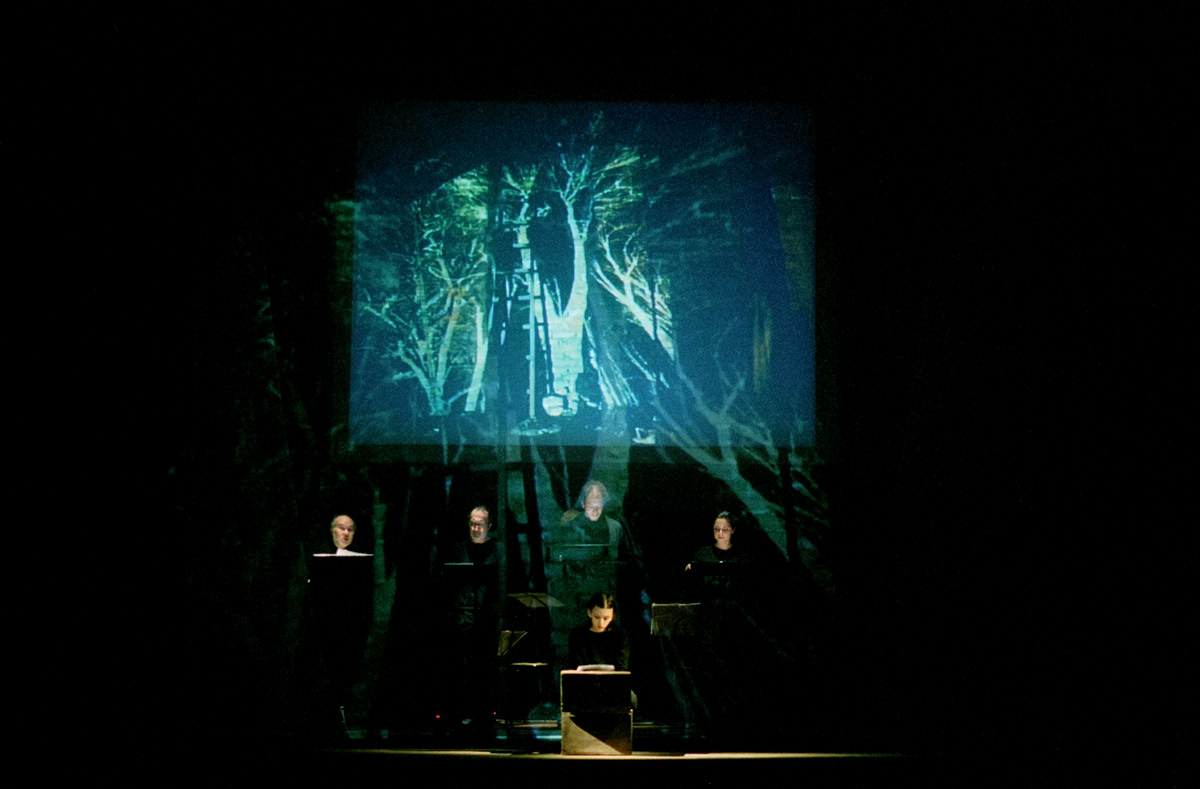
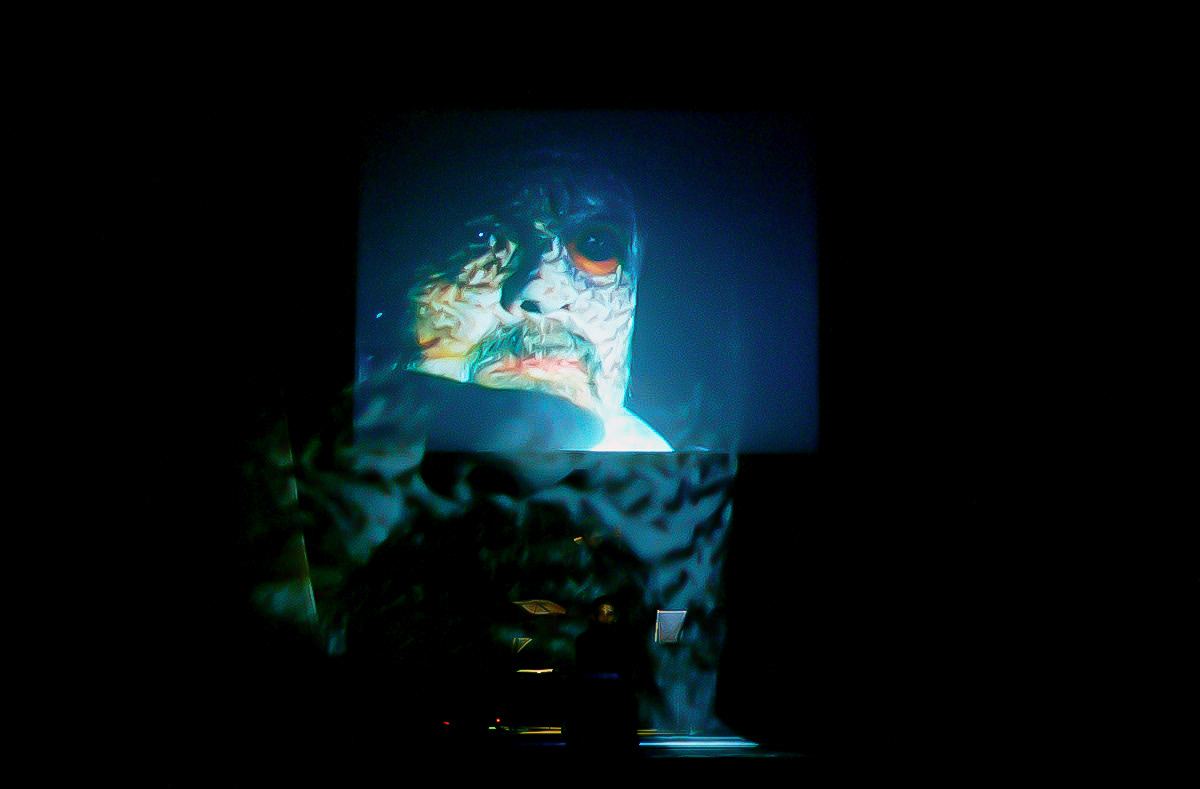
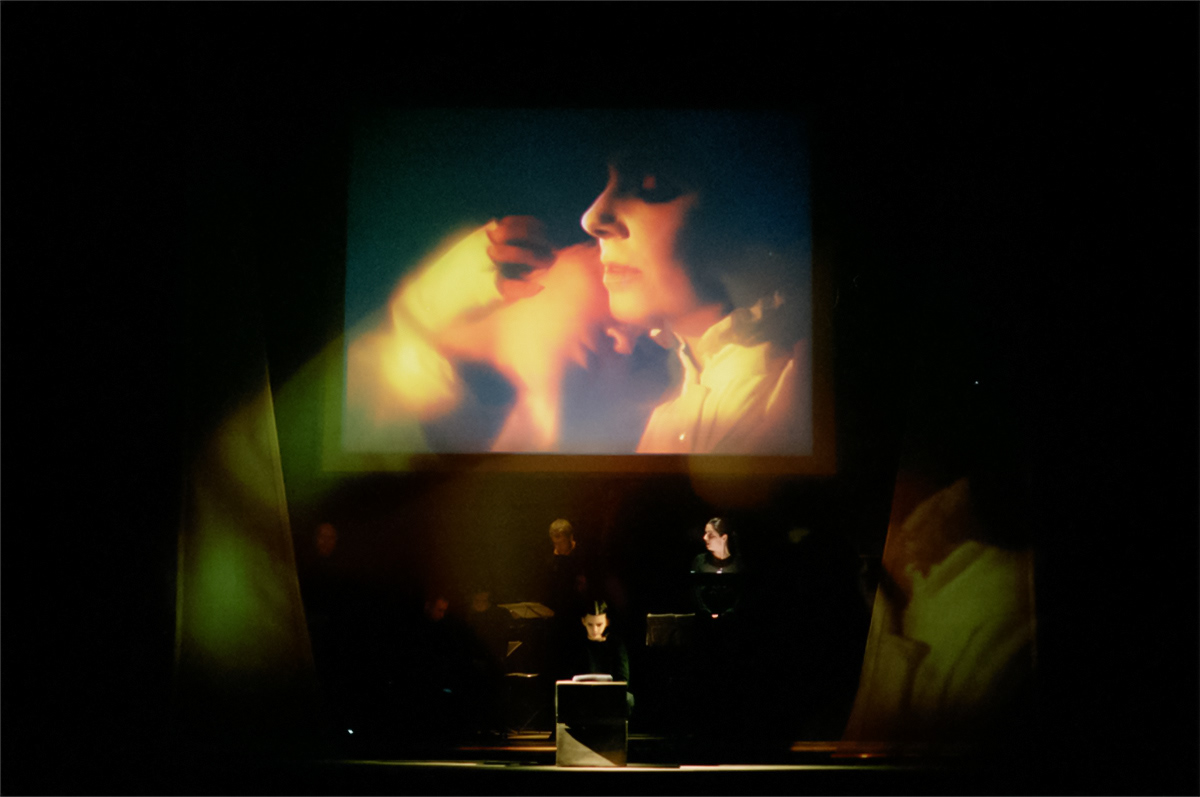
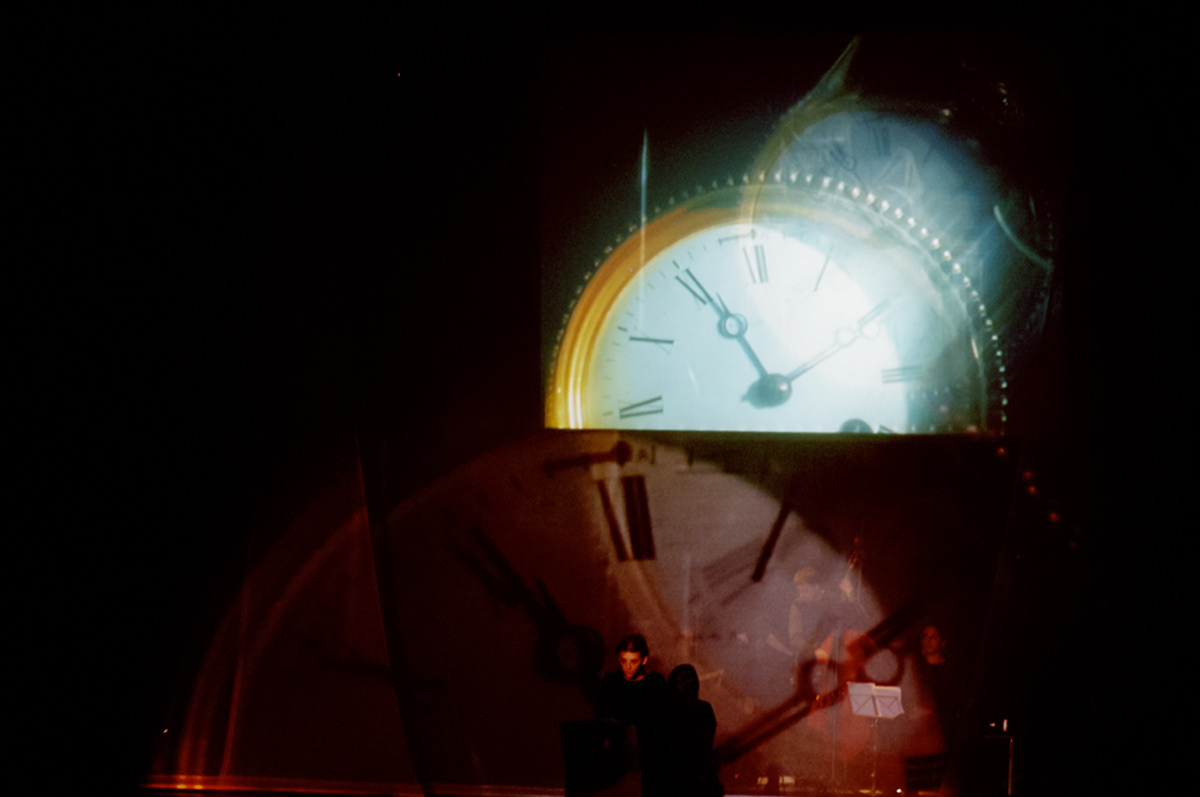
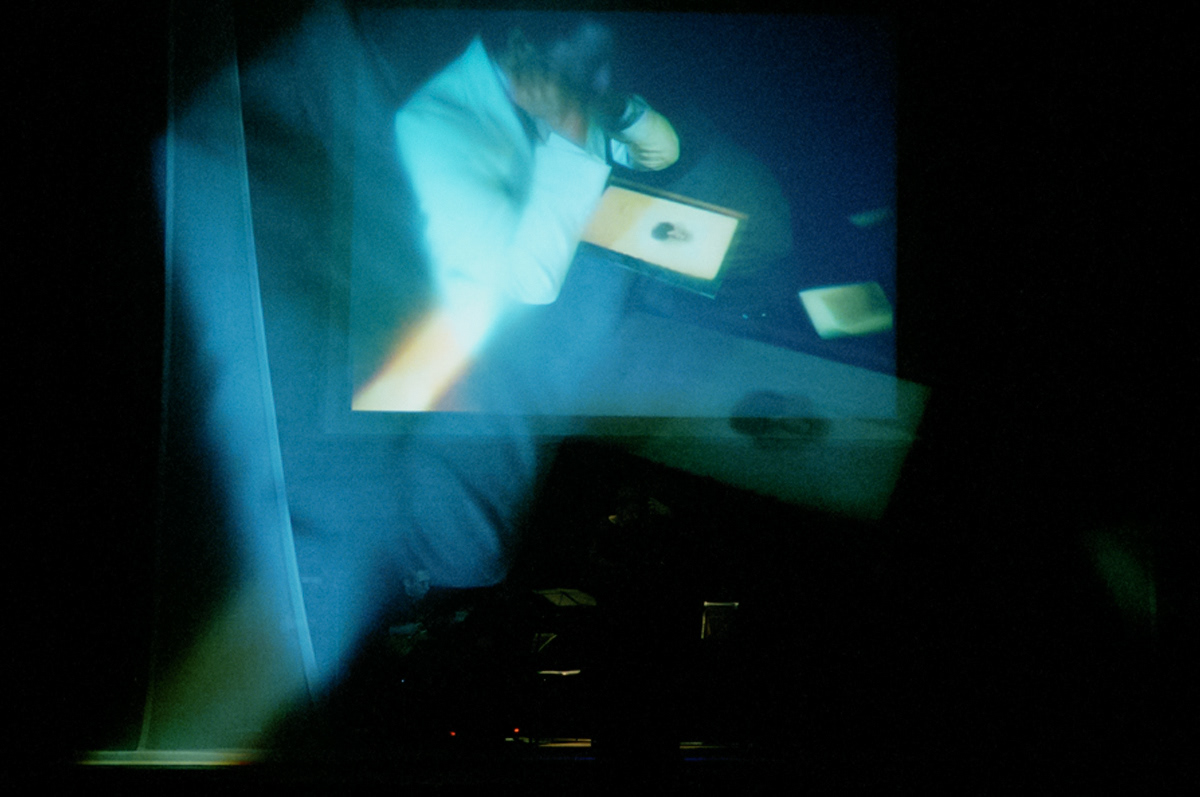
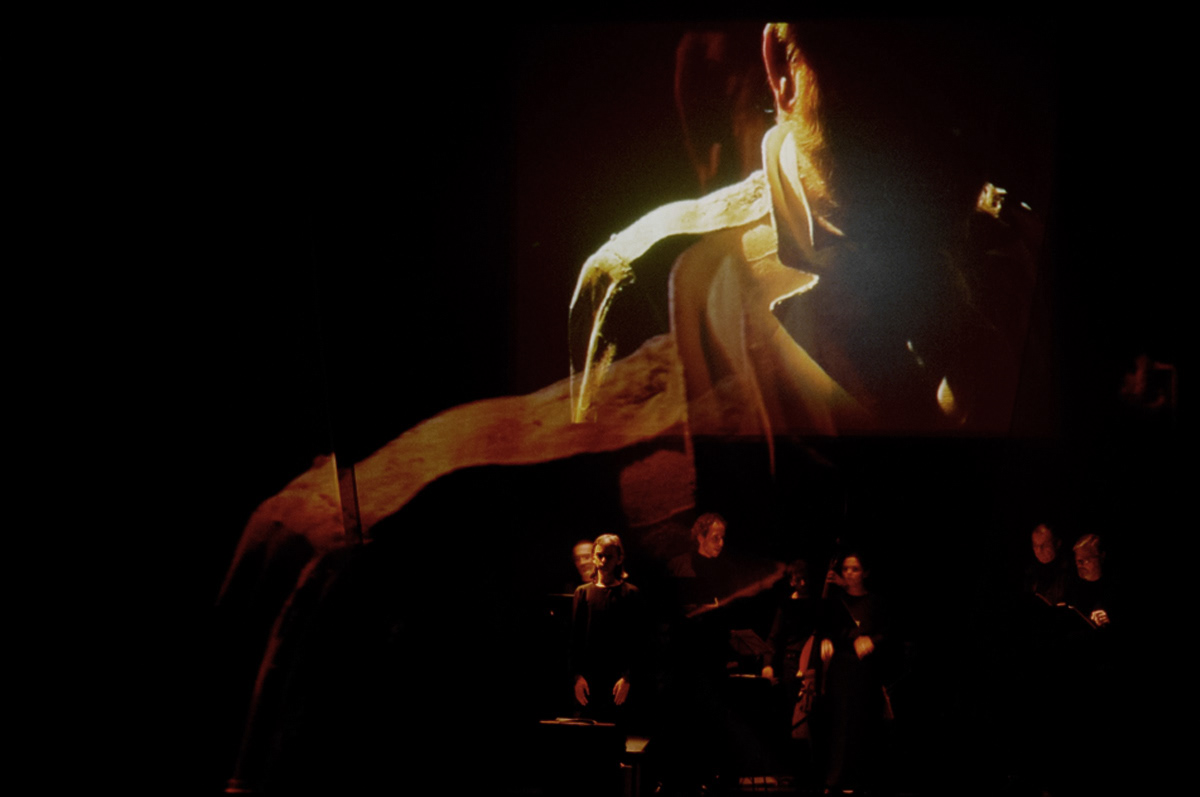
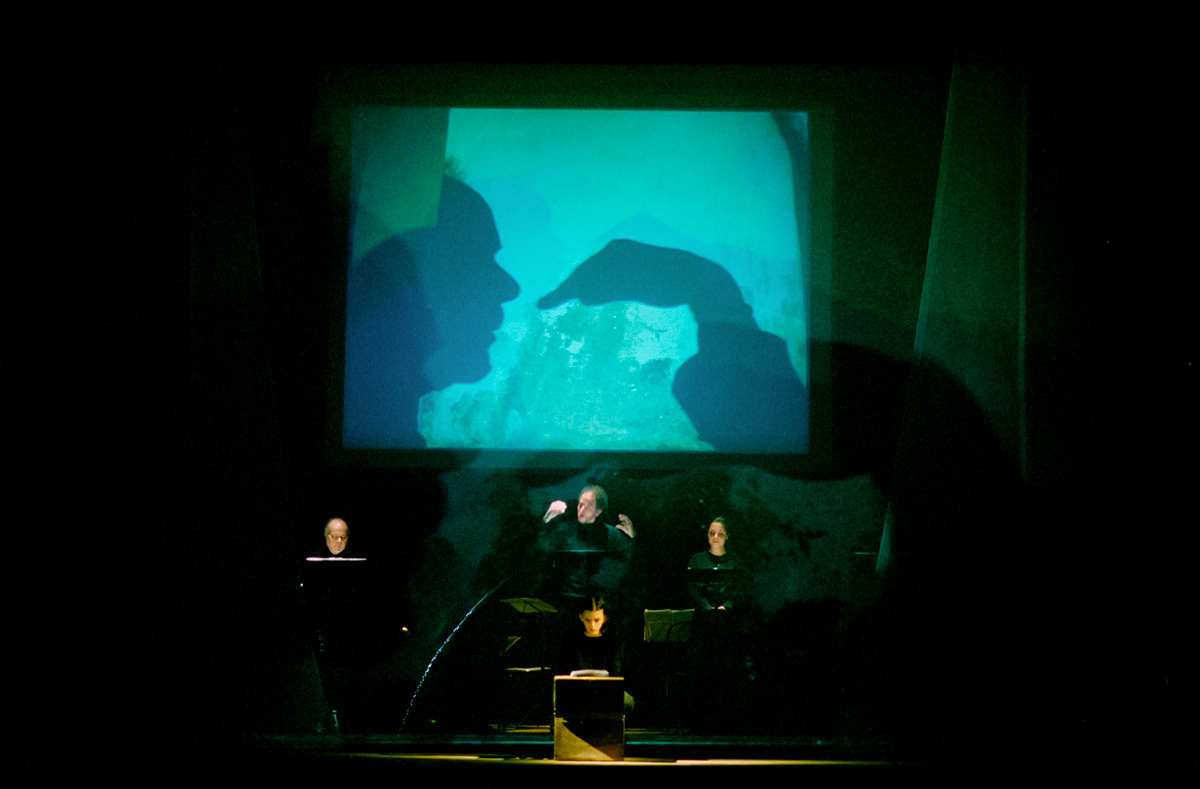

NOVELLA DEGLI SCACCHI (THE CHESS NOVEL) by Stefan Zweig
directed by Oliviero Corbetta
Actor: Gabriele Calindri
Live music: Architorti
Set design - Video Installation - Videography: Monica Chiappara
Sketches on paper: Fabio Franchini
Light design - Videography - Live direction: Davide Leone
Wigs - MUA: Audello Torino
Location shooting Video: Mole Antonelliana,Turin
Ship Conte Biancamano (National Museum of Science and Technology Leonardo Da Vinci, Milan)
Production: F.I.F. - 2002 (Fondazione Italiana per la Fotografia di Torino)
Teatro Giacosa - Ivrea
TECHNICAL DATA:
5 PLASMA MONITOR 50"
1 COMPUTER PC - 5 DVD PLAYERS
1 AUDIO MIXER - 1 DMX LIGHT MIXER - MICROPHONES
LOUDSPEAKERS
1 GIANT CHESSBOARD - GIANT CHESS
1 REGULAR CHESSBOARD - REGULAR CHESS
THEATRICALS NAVAL ROPES
IT___
Quando il regista mi parlò della sua idea di messa in scena del testo di Stefan Zweig ne fui entusiasta. La vicenda narrata dal testo di Zweig avviene durante un viaggio in nave da New York a Buenos Aires. Il teatro che avrebbe ospitato lo spettacolo sarebbe diventato per l'occasione una nave da crociera. L'impianto registico prevedeva l'utlizzo dei palchi come metaforico ponte della nave per ospitare attori, comparse, orchestra d'archi e pubblico; la platea rimase vuota. Il palcoscenico e il suo declivio sarebbe diventato il luogo ideale per ospitare una sfida scacchistica.
L'occasione era stimolante per molti aspetti: il teatro, quasi nella sua totalità, avrebbe avuto la doppia funzione di spazio scenico e contenitore della scenografia.
L'idea registica era di assegnare i personaggi del racconto ad un unico attore a cui era affidata la metamorfosi.
Realizzai l'idea suggerendo di filmare a camera fissa l'attore Gabriele Calindri e le sue diverse interpretazioni e inserirlo drammaturgicamente all'interno dell'impianto scenico con 5 monitor al plasma posti in verticale, assumendo la funzione di personaggio virtuale interattivo con il lato palchi che accoglieva la messa in scena teatrale. Il pubblico, dall'altro lato dei palchi, avrebbe ricoperto il canonico ruolo di pubblico pagante ma sarebbe stato investito anche del ruolo di pubblico-attore posto sullo stesso piano della struttura narrativa concepita nello spazio scenico.
Per l'occasione ci avvelemmo della preziosa collaborazione di Mario Audello e dei suoi spazi di via Mercanti a Torino per realizzare le riprese delle metamofosi di Gabriele Calindri con l'aiuto del trucco, delle parrucche, barbe e baffi messe a disposizione dal noto acconciatore torinese.
Alternate alle immagini dell'attore recitante, vennero realizzate riprese all'interno della Mole Antonelliana e della Nave Conte Biancamano conservata al Museo Nazionale della Scienza e della Tecnica Leonardo Da Vinci di Milano. Le suggestioni ottenute dalle immagini filmiche degli ambienti dell'epoca avevano l'obiettivo di creare un'atmosfera immersiva per il pubblico, chiamato ad una lettura multilivello del testo drammaturgico. La follia e la costrizione mentale dello scacchista protagonista Mirko Czentovič, e la propria ossessione per il gioco degli scacchi, venne racconato su due piani differenti: sui monitor con l'evocazione della costrizione psichiatrica attraverso i disegni astratti dell'amico Fabio Franchini e dalla partita di scacchi in contemporanea giocata sul palcoscenico su di una scacchiera in scala gigante.
I giocatori sul palco anticipavano le loro mosse su di una scacchiera regolare posta affianco la scacchiera gigante dentro cui avrebbero successivamente agito per rendere visibile al pubblico il loro gioco.
Dopo aver preparato i tasselli quadrati che avrebbero composto la scacchiera sul palco, mi ritrovai ad escogitare la gabbia mentale dei giocatori creando l'ingresso alla sfida scacchistica, anch'essa evocata nel luogo onirico che stava prendendo forma sul palcoscenico.
Le corde navali del teatro, normalmente utilizzate come tiri di scena per consentire l'uso del graticcio del palcoscenico per issare fondali e scenografie e le americane delle luci, vennero da me utilizzate per creare la gabbia-scacchiera.
La presenza del quintetto Architorti mi fece immaginare che il suono delle loro musiche dal vivo avrebbe vibrato tra le corde della scacchiera e interagito con la verticalità della scenografia.
Nove corde in levare partivano dalla base dei tre lati della scacchiera, escluso quello parallelo adiacente al proscenio, la quarta parete, e andavano a issarsi al graticcio del palco per un totale di ventisette corde.
Nel palco centrale, del lato palchi depuatato ad ospitare la rappresentazione, ha trovato posto anche Oliviero Corbetta il regista-doppiatore dei personaggi interpretati in video da Gabriele Calindri.
Grande fu l'impegno dal punto di vista della regia video live affidata con la regia luci a Davide Leone che realizzò con me anche le riprese video per i contributi dello spettacolo.
EN___
When director Oliviero Corbetta told me about his idea of staging Stefan Zweig's text, I was thrilled. The story narrated by Zweig's text takes place during a voyage by ship from New York to Buenos Aires. The theater that would host the show would become a cruise ship for the occasion. The directors envisaged the use of the boxes as a metaphorical bridge of the ship to host actors, extras, a string orchestra and the audience: the stalls remained empty. The stage and its slope would become the ideal place to host a chess challenge.
The occasion was stimulating for many aspects: the theater, almost in its entirety, would have had the double function of stage space and container of the scenography.
The directorial idea was to assign the characters of the story to a single actor who was entrusted with the metamorphosis.
I actualized the idea by suggesting to film the actor Gabriele Calindri and his various interpretations with a fixed camera and to insert it dramaturgically inside the stage set with 5 plasma monitors placed vertically, assuming the function of an interactive virtual character which welcomed the theatrical staging.
The public, on the other side of the boxes, would have held the canonical role of a paying public but would also have been invested in the role of public-actor placed on the same level as the narrative structure conceived in the stage space.
The public, on the other side of the boxes, would have held the canonical role of a paying public but would also have been invested in the role of public-actor placed on the same level as the narrative structure conceived in the stage space.
For the occasion we availed ourselves of the precious collaboration of Mario Audello and his spaces in via Mercanti in Turin to shoot the metamorphoses of Gabriele Calindri with the help of make-up, wigs, beards and mustaches made available by the well-known Turin hairdresser.
Alternating with the images of the actor were shots taken inside the Mole Antonelliana and the Conte Biancamano Ship kept at the National Museum of Science and Technology Leonardo Da Vinci in Milan. The suggestions obtained from the filmic images of the environments of “time gone” had the aim of creating an immersive atmosphere for the public, called to a multilevel reading of the dramaturgical text. The madness and mental constraint of the chess player protagonist Mirko Czentovič and his obsession with the game of chess, was narrated on two different levels: on the monitors with the evocation of psychiatric constraint through the abstract drawings of my friend Fabio Franchini and from the game of contemporary chess played on stage on a giant-scale chessboard.
The players on the stage anticipated their moves on a regular board placed next to the giant chessboard in which they would subsequently act to make their game visible to the audience.
After preparing the square pieces that would make up the chessboard on the stage, I found myself devising the mental cage of the players creating the entrance to the chess challenge, also evoked in the dreamlike place that was taking shape on the stage.
I utilized the naval ropes of the theater, normally used as props to allow the use of the stage trellis to hoist backdrops: scenographies and the trusses of the lights, to create the cage-chessboard.
The sound of the Architorti string quintet led me to imagine that the sound of live music would vibrate between the chessboard strings and interact with the verticality of the scenography.
Nine upward strings started from the base of the three sides of the chessboard, excluding the parallel one adjacent to the proscenium, and went to hoist themselves to the trellis of the stage for a total of twenty seven strings.
In the central stage, on the side of the boxes which were deputed to host the performance, was also Oliviero Corbetta, the director-voice actor of the characters interpreted in the video by Gabriele Calindri.
Great was the commitment from the point of view of the live video direction entrusted to Davide Leone along with the lighting and the video shooting carried out together with me for the contributions of the show.




GLI OCCHI DI GRETA GARBO (GRETA GARBO'S EYES) by Manuel Puig
directed by Oliviero Corbetta
Actors: Enrico Bertorelli, Adolfo Fenoglio, Emilio Frattini, Marco Morellini, Antonio Paiola,
Patrizia Salmoiraghi, Mario Scarabelli, Anna Bonasso, Gianni Mantesi.
Set design - Costume design - Video Installation - Videography: Monica Chiappara
Light design - Videography - Live video: Davide Leone
Live music: Bruno Coli
Production: F.I.F. - 2003 (Fondazione Italiana per la Fotografia di Torino)
Photo show: Alessandro Pinna
Teatro Giacosa - Ivrea
TECHNICAL DATA:
1PROJECTOR REAR
1 MIRROR
1 REAR PROJECTION SCREEN
1 COMPUTER PC
1 AUDIO MIXER - 1 DMX LIGHT MIXER - LOUDSPEAKERS
1 ARMCHAIR
3 CHAIRS
1 LITTLE TABLE
1 HAIRDRESSING TROLLEY FOR BEAUTY SALON
1 HAIRDRESSER HELMET
1 TELEPHONE
IT___
"Gli occhi Greta Garbo" mi ha fatto subito pensare all'iconicità dell'immagine cinematografica. Il testo graffiante ed emotivamente consolatorio di Manuel Puig è stato tradotto in scena dall'unicità di un grande schermo e da pochi arredi di scena ad interazione degli attori.
Sullo schermo, posto al fondo del palco, scorrono le immagini delle icone Greta Garbo in diversi ruoli dei suoi film e Silvana Mangano, non accreditata, nel ruolo della Madonna nel film "Decameron" di Pasolini. Il racconto sullo schermo ha sostenuto la narrazione/azione teatrale del testo messo in scena dal regista Oliviero Corbetta. La scena remake di una telefonata in macchina interagisce con l'attore sul palco. Alle spalle dell'attrice, impegnata in una conversazione telefonica, scorrono come panorama immagini di repertorio tratte dalle città utopiche concepite durante l'epoca dell'architettura futurista. Le riprese sono state girate in studio di posa con la vecchia tecnica del "trasparente" in cui su di uno schermo da retroproiezione scorrono i panorami come negli anni precedenti la tecnica del contemporaneo "chromakey" che permette di rendere trasparente il fondo bluescreen o greenscreen e inserire le immagini da utilizzare in post produzione. Una vecchia casa di campagna appare sullo schermo come abitata da fantasmi, in cui oggetti, arredi, porte e finestre si muovono manovrati da fili di nylon invisibili alla percezione dell'occhio umano. Il mito e l'icona di Greta Garbo riecheggia mutevole e malinconicamente evocata dalla figura letteraria del regista Max Ophüls, interpretato in scena dall'attore Gianni Mantesi.
Questi alcuni dei sette close-up cinematografici raccontati nel testo di Manuel Puig e trasposti in scena.
EN___
"Greta Garbo's eyes" immediately made me think of the iconicity of this cinematic frame. Manuel Puig's biting and emotionally consoling text was translated onto the stage by the uniqueness of a large screen and a few stage furnishings for the interaction of the actors.
On the screen, placed at the bottom of the stage, scrolled the images of the iconic Greta Garbo in her various film roles and Silvana Mangano, uncredited, in the role of the Madonna in Pasolini's film "Decameron". La Mangano relives in the memory and emotion of two characters, in a beauty salon, her loaded sexual orientation crowns the divine actress as a gay icon. The story on the screen supported the narration and theatrical action of the text staged by the director Oliviero Corbetta. The remake scene of a car phone call interacts with the actor on stage. Behind the actress engaged in a telephone conversation, a panorama of archive images from the utopian cities conceived during the era of Futurist architecture flew by. The shots were taken in the studio by means of the old "transparent" technique in which the panoramas slide on a rear-projection screen , similar to the contemporary “chromakey” technique, used in previous years, which allows the bluescreen or greenscreen background to become transparent and inserts the images to be used in post-production.
An old country house appeared on the screen as if inhabited by ghosts, in which objects, furnishings, doors and windows moved, maneuvered by nylon threads invisible to the perception of the human eye. The myth and icon of Greta Garbo echoed mutely and melancholically, evoked by the literary figure of director Max Ophüls, played on stage by the actor Gianni Mantesi.
These are some of the seven cinematic close-ups recounted in Manuel Puig's text and transposed on stage.
An old country house appeared on the screen as if inhabited by ghosts, in which objects, furnishings, doors and windows moved, maneuvered by nylon threads invisible to the perception of the human eye. The myth and icon of Greta Garbo echoed mutely and melancholically, evoked by the literary figure of director Max Ophüls, played on stage by the actor Gianni Mantesi.
These are some of the seven cinematic close-ups recounted in Manuel Puig's text and transposed on stage.

ph. Alessandro Pinna

